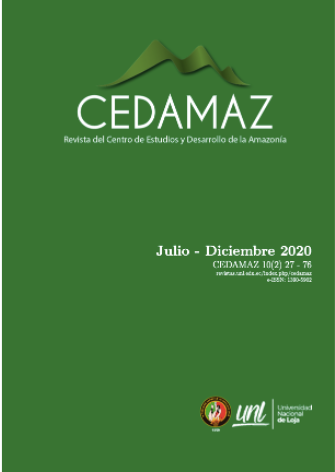Implementation of oxo-biodegradable plastic bags and their social and environmental impact in the city of Loja, Ecuador
Abstract
The following research studies the social and environmental impact caused by the use of oxo-biodegradable bags, which use has been implemented in Loja city through municipal ordinance (N° 044-2017 and its reform N° 050-2017). Due to the persistence of plastic in the environment, it is necessary to test if oxo-biodegradable bags reduce environmental damage in comparison to conventional polyethylene plastic bags. Data was collected through surveys addressed to store owners and their customers; based on this data, a social impact evaluation matrix was developed. To determine the environmental impact caused by oxo-biodegradable bags, the Life Cycle Analysis (LCA) method was applied, using the SimaPro software 8.5.2.0. The study area was located in downtown Loja, where the city’s commerce concentrates and the use of plastic bags is abundant. As a result, despite the positive acceptance of the oxo-biodegradable bags by the population (65 %), these do not provide an improvement to the environment because optimal conditions for their degradation (temperature, oxygen, and UV radiation) are not present in landfill, where they spend their last stage of life. It was found that ecotoxicity and human toxicity are the greatest environmental impacts generated during the entire life cycle of oxo-biodegradable bags, and that the difference between common plastic bags and oxo-biodegradable ones, in terms of environmental impacts, is minimal.Published
2020-12-31
How to Cite
Hernández Ocampo, R. V., García Matailo, S. R. ., & Santos-Orellana, V. J. . (2020). Implementation of oxo-biodegradable plastic bags and their social and environmental impact in the city of Loja, Ecuador. CEDAMAZ, 10(2), 57–63. Retrieved from https://revistas.unl.edu.ec/index.php/cedamaz/article/view/881
Issue
Section
Review Articles
License

This work is licensed under a Creative Commons Attribution-NonCommercial-NoDerivatives 4.0 International License.
Those authors who have publications with this journal, accept the following terms:
- After the scientific article is accepted for publication, the author agrees to transfer the rights of the first publication to the CEDAMAZ Journal, but the authors retain the copyright. The total or partial reproduction of the published texts is allowed as long as it is not for profit. When the total or partial reproduction of scientific articles accepted and published in the CEDAMAZ Journal is carried out, the complete source and the electronic address of the publication must be cited.
- Scientific articles accepted and published in the CEDAMAZ journal may be deposited by the authors in their entirety in any repository without commercial purposes.
- Authors should not distribute accepted scientific articles that have not yet been officially published by CEDAMAZ. Failure to comply with this rule will result in the rejection of the scientific article.
- The publication of your work will be simultaneously subject to the Attribution-NonCommercial-NoDerivatives 4.0 International (CC BY-NC-ND 4.0)









